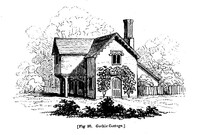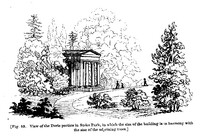It is not sufficient that a building should be in just proportions with itself; it should bear some relative proportion to the objects near it. The example here given [fig. 89] is the Doric portico at STOKE PARK, in Herefordshire, where the size of the building was regulated by a large oak and a young plantation near it: had this building been more lofty, it would have overpowered the young trees, by which it is surrounded, and a smaller building would have appeared diminutive so near to the neighbouring large oak; I there- fore judged, that the best rule for the dimensions of the column's was rather less than the diameter of the oak, and this, of course, determined the whole proportion of the Doric portico. So prevalent is the taste for what is called Gothic, in the neighbourhood of great cities, that we see buildings of every description, from the villa to the pigsty, with little pointed arches, or battlements, to look like Gothic; and a Gothic dairy is now become as common an appendage to a place, as were formerly the hermitage, the grotto, or the Chinese pavilion. Why the dairy should be Gothic, when the house is not so, I cannot understand, unless it arises from that great source of bad taste, to introduce what is called a pretty thing, without any reference to its character, situation, or uses. Even in old Gothic cottages we never see the sharp-pointed arch, but often the flat arch of Henry VIII., and perhaps there is no form more picturesque for a cottage than buildings of that date, especially as their lofty perforated chimneys not only contribute to the beauty of the outline, but tend to remedy the curse of the poor man's fire-side, a smoky house [see fig. 90].



